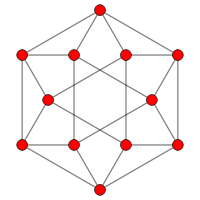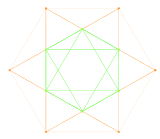G2 (mathematics)
| Algebraic structure → Group theory Group theory |
|---|
|
Modular groups
|
Infinite dimensional Lie group
|
| Group theory → Lie groups Lie groups |
|---|
|
|
In mathematics, G2 is the name of three simple Lie groups (a complex form, a compact real form and a split real form), their Lie algebras  , as well as some algebraic groups. They are the smallest of the five exceptional simple Lie groups. G2 has rank 2 and dimension 14. It has two fundamental representations, with dimension 7 and 14.
, as well as some algebraic groups. They are the smallest of the five exceptional simple Lie groups. G2 has rank 2 and dimension 14. It has two fundamental representations, with dimension 7 and 14.
The compact form of G2 can be described as the automorphism group of the octonion algebra or, equivalently, as the subgroup of SO(7) that preserves any chosen particular vector in its 8-dimensional real spinor representation. Robert Bryant introduced the definition of G2 as the subgroup of  that preserves the non-degenerate 3-form
that preserves the non-degenerate 3-form
(invariant under the cyclic permutation (0123456)) with  denoting
denoting 
In older books and papers, G2 is sometimes denoted by E2.
Real forms
There are 3 simple real Lie algebras associated with this root system:
- The underlying real Lie algebra of the complex Lie algebra G2 has dimension 28. It has complex conjugation as an outer automorphism and is simply connected. The maximal compact subgroup of its associated group is the compact form of G2.
- The Lie algebra of the compact form is 14-dimensional. The associated Lie group has no outer automorphisms, no center, and is simply connected and compact.
- The Lie algebra of the non-compact (split) form has dimension 14. The associated simple Lie group has fundamental group of order 2 and its outer automorphism group is the trivial group. Its maximal compact subgroup is SU(2) × SU(2)/(−1,−1). It has a non-algebraic double cover that is simply connected.
Algebra
Dynkin diagram and Cartan matrix
The Dynkin diagram for G2 is given by ![]() .
.
Its Cartan matrix is:
Roots of G2
 The 12 vector root system of G2 in 2 dimensions. |
 The A2 Coxeter plane projection of the 12 vertices of the cuboctahedron contain the same 2D vector arrangement. |
 Graph of G2 as a subgroup of F4 and E8 projected into the Coxeter plane |
Although they span a 2-dimensional space, as drawn, it is much more symmetric to consider them as vectors in a 2-dimensional subspace of a three-dimensional space.
|
|
One set of simple roots, for ![]()
![]()
![]() is:
is:
- (0,1,−1), (1,−2,1)
Weyl/Coxeter group
Its Weyl/Coxeter group is the dihedral group, D6 of order 12.
Special holonomy
G2 is one of the possible special groups that can appear as the holonomy group of a Riemannian metric. The manifolds of G2 holonomy are also called G2-manifolds.
Polynomial Invariant
G2 is the automorphism group of the following two polynomials in 7 non-commutative variables.

 (± permutations)
(± permutations)
which comes from the octonion algebra. The variables must be non-commutative otherwise the second polynomial would be identically zero.
Generators
Adding a representation of the 14 generators with coefficients A..N gives the matrix:
Representations
The characters of finite-dimensional representations of the real and complex Lie algebras and Lie groups are all given by the Weyl character formula. The dimensions of the smallest irreducible representations are (sequence A104599 in OEIS):
- 1, 7, 14, 27, 64, 77 (twice), 182, 189, 273, 286, 378, 448, 714, 729, 748, 896, 924, 1254, 1547, 1728, 1729, 2079 (twice), 2261, 2926, 3003, 3289, 3542, 4096, 4914, 4928 (twice), 5005, 5103, 6630, 7293, 7371, 7722, 8372, 9177, 9660, 10206, 10556, 11571, 11648, 12096, 13090….
The 14-dimensional representation is the adjoint representation, and the 7-dimensional one is action of G2 on the imaginary octonions.
There are two non-isomorphic irreducible representations of dimensions 77, 2079, 4928, 28652, etc. The fundamental representations are those with dimensions 14 and 7 (corresponding to the two nodes in the Dynkin diagram in the order such that the triple arrow points from the first to the second).
Vogan (1994) described the (infinite-dimensional) unitary irreducible representations of the split real form of G2.
Finite groups
The group G2(q) is the points of the algebraic group G2 over the finite field Fq. These finite groups were first introduced by Leonard Eugene Dickson in Dickson (1901) for odd q and Dickson (1905) for even q. The order of G2(q) is q6(q6 − 1)(q2 − 1). When q ≠ 2, the group is simple, and when q = 2, it has a simple subgroup of index 2 isomorphic to 2A2(32), and is the automorphism group of a maximal order of the octonions. The Janko group J1 was first constructed as a subgroup of G2(11). Ree (1960) introduced twisted Ree groups 2G2(q) of order q3(q3 + 1)(q − 1) for q = 32n+1, an odd power of 3.
See also
- Cartan matrix
- Dynkin diagram
- Exceptional Jordan algebra
- Fundamental representation
- G2-structure
- Lie group
- Seven-dimensional cross product
- Simple Lie group
References
- Adams, J. Frank (1996), Lectures on exceptional Lie groups, Chicago Lectures in Mathematics, University of Chicago Press, ISBN 978-0-226-00526-3, MR 1428422
- Agricola, Ilka (2008), Old and New on the Exceptional Group G2 (PDF) 55 (8)
- Baez, John (2002), "The Octonions", Bull. Amer. Math. Soc. 39 (2): 145–205, doi:10.1090/S0273-0979-01-00934-X.
- See section 4.1: G2; an online HTML version of which is available at http://math.ucr.edu/home/baez/octonions/node14.html.
- Bryant, Robert (1987), "Metrics with Exceptional Holonomy", Annals of Mathematics, 2 126 (3): 525–576, doi:10.2307/1971360
- Dickson, Leonard Eugene (1901), "Theory of Linear Groups in An Arbitrary Field", Transactions of the American Mathematical Society (Providence, R.I.: American Mathematical Society) 2 (4): 363–394, doi:10.1090/S0002-9947-1901-1500573-3, ISSN 0002-9947, JSTOR 1986251, Reprinted in volume II of his collected papers Leonard E. Dickson reported groups of type G2 in fields of odd characteristic.
- Dickson, L. E. (1905), "A new system of simple groups", Math. Ann. 60: 137–150, doi:10.1007/BF01447497 Leonard E. Dickson reported groups of type G2 in fields of even characteristic.
- Ree, Rimhak (1960), "A family of simple groups associated with the simple Lie algebra of type (G2)", Bulletin of the American Mathematical Society 66 (6): 508–510, doi:10.1090/S0002-9904-1960-10523-X, ISSN 0002-9904, MR 0125155
- Vogan, David A. Jr. (1994), "The unitary dual of G2", Inventiones Mathematicae 116 (1): 677–791, doi:10.1007/BF01231578, ISSN 0020-9910, MR 1253210


![\left [\begin{smallmatrix}
\;\,\, 2&-3\\
-1&\;\,\, 2
\end{smallmatrix}\right ]](../I/m/43d0e367343984e2cc0330bd6cf1e9d8.png)
